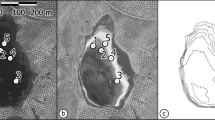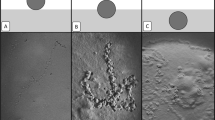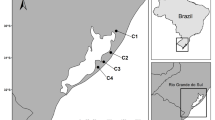Abstract
Organisms living in intermittent wetlands present adaptations to cope with the inundation-desiccation process. Microcrustaceans are commonly found in intermittent wetlands because they present reproductive strategies able to synchronize with the hydroperiod. To know the dynamic of the microcrustaceans, that inhabit these wetlands of the subtropical coastal plain, which predominate the Pampas biome in Brazil, we analyzed the influence of hydration time and temperature on the hatching of microcrustaceans, comparing in situ and ex situ approaches. We followed hatching 34 days after in situ flooding and tested three temperatures (10, 15, and 20°C) 30 days after laboratory flooding. In both approaches, we classified the hydration time as the beginning, middle, and end of the hydroperiod. We recorded a total of 41 taxa distributed in Cladocera (26 taxa), Ostracoda (8), Copepoda (3), Anostraca (1), and Conchostraca (1). We observed that in situ hydration time was the most important factor for hatching. Ex situ hydration time was also important, but the increase in temperature positively affected the hatching of organisms. We also found that in both approaches, the beginning of hydration time is the most important period for the hatching of microcrustaceans.




Similar content being viewed by others
References
Albertoni, E. F., C. Palma-Silva, C. R. Trindade & L. M. Furlanetto, 2014. Field evidence influence of aquatic macrophytes on water quality in a shallow eutrophic lake over a 13-year period. Acta Limnologica Brasiliensia 26: 176–185.
Alekseev, V. R., B. De Stasio & J. J. Gilbert, 2007. Diapause in Aquatic Invertebrates: theory and Human Use. Springer, Dordrecht.
Allen, P. E. & S. I. Dodson, 2011. Land use and ostracod community structure. Hydrobiologia 668: 203–219.
Alvares, C. A., J. L. Stape, P. C. Sentelhas, J. L. M. Gonçalves & G. Sparovek, 2014. Köppen’s climate classification map for Brazil. Meteorologische Zeitschrift 22: 711–728.
Antón-Pardo, M., X. Armengol & R. Ortells, 2016. Zooplankton biodiversity and community structure vary along spatiotemporal environmental gradients in restored peridunal ponds. Journal of Limnology 75: 193–203.
Bandeira, M. G. S., K. P. Martins, C. Palma-Silva, L. U. Hepp & E. F. Albertoni, 2019. Strategy for the hatching of microcrustaceans endemic to intermittent environments along annual hydroperiods. In Mendes, L. N. (ed.), Crustáceos: ecossistema, classificação e reprodução. Atena Editora, Ponta Grossa, PR: 34–46.
Batzer, D. & D. Boix, 2016. Invertebrates in freshwater wetlands. Springer, Cham.
Bird, M. S., M. C. Mlambo, R. J. Wasserman, T. Dalu, A. J. Holland, J. A. Day, M. H. Villet, D. T. Bilton, H. M. Barber-James & L. Brendonck, 2018. Deeper knowledge of shallow waters: reviewing the invertebrate fauna of southern African temporary wetlands. Hydrobiologia 827: 89–121.
Brendonck, L. & De L. Meester, 2003. Egg banks in freshwater zooplankton: evolutionary and ecological archives in the sediment. Hydrobiologia 49: 65–84.
Brendonck, L., D. C. Rogers, J. Olesen, S. Weeks & W. R. Hoeh, 2008. Global diversity of large branchiopods (Crustacea: Branchiopoda) in freshwater. Hydrobiologia 595: 167–176.
Buckup, L. & G. Bond-Buckup, 1999. Os crustáceos do Rio Grande do, Sul ed. Universidade/UFRGS, Porto Alegre.
Cáceres, C. E. & M. S. Schwalbach, 2001. How well do laboratory experiments explain Field patterns of zooplankton emergence? Freshwater Biology 46: 1179–1189.
Cáceres, C. E., A. N. Christoff & W. J. Boeing, 2007. Variation in ephippial buoyancy in Daphnia pulicaria. Freshwater Biology 52: 313–318.
César, I. I., 1990. Primer registro de Branchinecta iheringi Lilljeborg (Crustacea: Anostraca) para la Argentina. Revista de la Asociacion de Ciencias Naturales del Litoral 19: 101–111.
Chaparro, G., M. S. Fontanarrosa & I. O’Farrell, 2016. Colonization and succession of zooplankton after a drought: influence of hydrology and free-floating plant dynamics in a floodplain lake. Wetlands 36: 85–100.
Chaparro, G., Z. Horváth, I. O’Farrell, R. Ptacnik & T. Hein, 2018. Plankton metacommunities in floodplain wetlands under contrasting hydrological conditions. Freshwater Biology 63: 380–391.
Crawley, M. J., 2007. The R Book. Wiley, New York.
Cui, B., Q. He, B. Gu, J. Bai & X. Liu, 2016. China’s coastal wetlands: understanding environmental changes and human impacts for management and conservation. Wetlands 36: S1–S9.
De Stasio, B. T., 1989. The seed bank of a freshwater crustacean: copepodology for the plant ecologist. Ecology 70: 1377–1389.
Dussart, B. H. & D. Defaye, 2001. Introduction to the Copepoda. Backhuys Publishers, Leiden.
Elmoor-Loureiro, L. M. A., 1997. Manual de identificação de Cladóceros Límnicos do Brasil. Ed. Universa, Brasília, Brasil
Eskinazi-Sant’Anna, E. M. & M. L. Pace, 2018. The potential of the zooplankton resting-stage bank to restore communities in permanent and temporary waterbodies. Journal of Plankton Research 40: 1–13.
Fernando, C. H., 2002. A guide to tropical freshwater zooplankton. Backhuys, Leiden.
Florencio, M., C. Díaz-Paniagua & L. Serrano, 2016. Relationships between hydroperiod length, and seasonal and spatial patterns of beta-diversity of the microcrustacean assemblages in Mediterranean ponds. Hydrobiologia 774: 109–121.
Florencio, M., R. Fernández-Zamudio, M. Lozano & C. Díaz-Paniagua, 2020. Interannual variation in filling season affects zooplankton diversity in Mediterranean temporary ponds. Hydrobiologia 847: 1195–1205.
Freiry, R. F., V. Weber, C. C. Bonecker, F. A. Lansac-Tôha, M. M. Pires, C. Stenert & L. Maltchik, 2020. Additive partitioning of the diversity of the dormant zooplankton communities in intermittent ponds along a forest–grassland transition. Hydrobiologia 847: 1327–1342.
García-de-Lomas, J., J. Sala, V. Barrios, F. Prunier, A. Camacho, M. Machado, M. Alonso, M. Korn, D. Boix, F. Hortas, C. M. García, L. Serrano & G. Muñoz, 2017. How threatened are large branchiopods (Crustacea, Branchiopoda) in the Iberian Peninsula? Hydrobiologia 801: 99–116.
Gerhard, M., C. Iglesias, J. M. Clemente, G. Goyenola, M. Meerhoff, J. P. Pacheco, F. T. Mello & N. Mazzeo, 2017. What can resting egg banks tell about cladoceran diversity in a shallow subtropical lake? Hydrobiologia 798: 75–86.
Gray, D. K. & S. E. Arnott, 2012. The role of dispersal levels, Allee effects and community resistance as zooplankton communities respond to environmental change. Journal of Applied Ecology 49: 1216–1224.
Iglesias, C., C. Bonecker, L. Brandão, M. C. Crispim, M. C. Eskinazi-Sant’Anna, M. Gerhard, J. L. Portinho, P. Maia-Barbosa, E. Panarelli & J. M. Santangelo, 2016. Current knowledge of South American cladoceran diapause: a brief review. Int. Rev. Hydrobiologia 101: 1–14.
James, C. S., M. C. Thoms & G. P. Quinn, 2008. Zooplankton dynamics from inundation to drying in a complex ephemeral floodplain-wetland. Aquatic Sciences 70: 259–271.
Jones, N. T. & B. Gilbert, 2016. Changing climate cues differentially alter zooplankton dormancy dynamics across latitudes. Journal of Animal Ecology 85: 559–569.
Korovchinsky, N. M., 1992. Sididae e Holopedidae (Crustacea: Daphniiformes). SPB Academic Publishing, The Hague.
Maltchik, L., 2003. Three new wetlands inventories in Brazil. Interciencia 28: 421–423.
Maltchik, L., A. S. Rolon, D. L. Guadagnin & C. Stenert, 2004. Wetlands of Rio Grande do Sul, Brazil: a classification with emphasis on plant communities. Acta Limnologica Brasiliensia 16: 137–151.
Marinone, M. C., J. I. Urcola & N. Rabet, 2016. Review of the Eulimnadia (Branchiopoda: Spinicaudata: Limnadiidae) from Argentina with the description of a new species. Zootaxa 4158: 419–432.
Martins, K. P., M. G. S. Bandeira, C. Palma-Silva & E. F. Albertoni, 2019. Microcrustacean metacommunities in urban temporary ponds. Aquatic Sciences 81: 56.
Moreno, E., C. Pérez-Martínez & J. M. Conde-Porcuna, 2019. Dispersal of rotifers and cladocerans by waterbirds: seasonal changes and hatching success. Hydrobiologia 834: 145–162.
Nhiwatiwa, T., L. Brendonck & T. Dalu, 2017. Understanding factors structuring zooplankton and macroinvertebrate assemblages in ephemeral pans. Limnologica 64: 11–19.
Oksanen, J., F. G. Blanchet, M. Friendly, R. Kindt, P. Legendre, D. McGlinn, P. R. Minchin, R. B. O’Hara, G. L. Simpson, P. Solymos, M. H. H. Stevens, E. Szoecs, & H. Wagner, 2018. Vegan: Community Ecology Package. R package version 2.5-3. https://CRAN.R-project.org/package=vegan.
Paes, T. A. S. V., A. C. Rietzler, D. G. F. Pujoni & P. M. Maia-Barbosa, 2016. High temperatures and absence of light affect the hatching of resting eggs of Daphnia in the tropics. An. Academia Brasileira de Ciências 88: 179–186.
Perçin-Paçal, F., 2019. Spatiotemporal Distribution and Habitat Preferences of Ostracods in the Coastal Karagöl Lagoon, Enez, Edirne, Turkey. Acta Zoologica Bulgarica 71: 589–596.
Pérez-Martínez, C., L. Jiménez, E. Moreno & J. M. Conde-Porcuna, 2013. Emergence pattern and hatching cues of Daphnia pulicaria (Crustacea, Cladocera) in an alpine lake. Hydrobiologia 707: 47–57.
R Core Team, 2018. R: A language and environment for statistical computing. R Foundation for Statistical Computing, Vienna, Austria. URL https://www.R-project.org/.
Reis, J. R., O. M. Lima, & R. A. Borges, 2013. RT4Bio - R Tools for Biologists. This is developed in the Laboratory of Behavioural Ecology and Computational Biology at State Universite of Montes Claros - MG - Brazil. https://www.openhub.net/p/rt4bio.
Ricci, C., 2001. Dormancy patterns in rotifers. Hydrobiologia 446(447): 1–11.
Rogers, D. C., A. Dunn & W. W. Price, 2019. A review of Dendrocephalus (Dendrocephalinus) (Crustacea: Anostraca) with the first records of male-male anostracan aggressive competition. European Journal of Taxonomy 509: 1–14.
Sabnis, N. J., M. R. Kulkarnia, S. M. Padhyeb & K. Pai, 2017. Hatching phenology, life history and population dynamics of the Oriental clam shrimp Eulimnadia indocylindrova Durga Prasad and Simhachalam with notes on phenology patterns in the Spinicaudata. Journal of Natural History 51: 1835–1849.
Santangelo, J. M., 2009. Produção, eclosão e implicações ecológicas e evolutivas dos estágios dormentes do zooplâncton. Limnotemas, Rio de Janeiro.
Sim, L. L., J. A. Davis, K. Strehlow, M. McGuire, K. M. Trayler, S. Wild, P. J. Papas & J. O’Connor, 2013. The influence of changing hydroregime on the invertebrate communities of temporary seasonal wetlands. Freshwater Science 32: 327–342.
Smirnov, N. N., 1996. Cladocera: the Chydoridae and Sayciinae (Chydoridae) of the world. SPB Academic Publishing, Amsterdam.
Van Damme, K. & H. J. Dumont, 2010. Cladocera of the Lençóis Maranhenses (NE - Brazil): faunal composition and a reappraisal of Sars’ Method. Brazilian Journal of Biology 70: 755–779.
Vargas, A. L., J. M. Santangelo & R. L. Bozelli, 2019. Recovery from drought: viability and hatching patterns of hydrated and desiccated zooplankton resting eggs. International Review of Hydrobiology 104: 26–33.
Venables, W. N. & B. D. Ripley, 2002. Modern Applied Statistics with S, 4rt ed. Springer, New York. ISBN 0-387-95457-0.
Waterkeyn, A., B. Vanschoenwinkel, P. Grillas & L. Brendonck, 2010. Effect of salinity on seasonal community patterns of Mediterranean temporary wetland crustaceans: a mesocosm study. Limnology and Oceanography 55: 1712–1722.
Acknowledgements
To the reviewers for the contributions those were fundamental to our manuscript. To Dr. Koen Martens for the discerning revision of the final version of the manuscript. To the technicians of the Laboratory of Limnology of the Federal University of Rio Grande (FURG) CláudioTrindade, Leonardo Furlanetto, and Clara Silva. To Dr. Paulina Maia Barbosa and technician Rosa Maria Menendez of the Federal University of Minas Gerais (UFMG) for the support in the Cladocera, Conchostraca, and Anostraca identification. To the colleagues of the invertebrate group for the support in the readings and corrections of the manuscript. To Dr. Fabiana Barbosa and Dr. Paul Kinas of the Federal University of Rio Grande (FURG) for their support in statistical analysis. MGSB received a scholarship from the Coordenação de Aperfeiçoamento de Pessoal de Nível Superior—Brazil (CAPES)—Financing code 001. LUH received financial support from the National Council for Research and Development (CNPq, Proc.#421632/2016-0 and Proc.#305203/2017-7).
Author information
Authors and Affiliations
Corresponding author
Additional information
Handling editor: Dani Boix
Publisher's Note
Springer Nature remains neutral with regard to jurisdictional claims in published maps and institutional affiliations.
Electronic supplementary material
Below is the link to the electronic supplementary material.
Rights and permissions
About this article
Cite this article
da Silva Bandeira, M.G., Martins, K.P., Palma-Silva, C. et al. Hydration time influences microcrustacean hatching in intermittent wetlands: in situ and ex situ approaches. Hydrobiologia 847, 3227–3245 (2020). https://doi.org/10.1007/s10750-020-04315-w
Received:
Revised:
Accepted:
Published:
Issue Date:
DOI: https://doi.org/10.1007/s10750-020-04315-w




